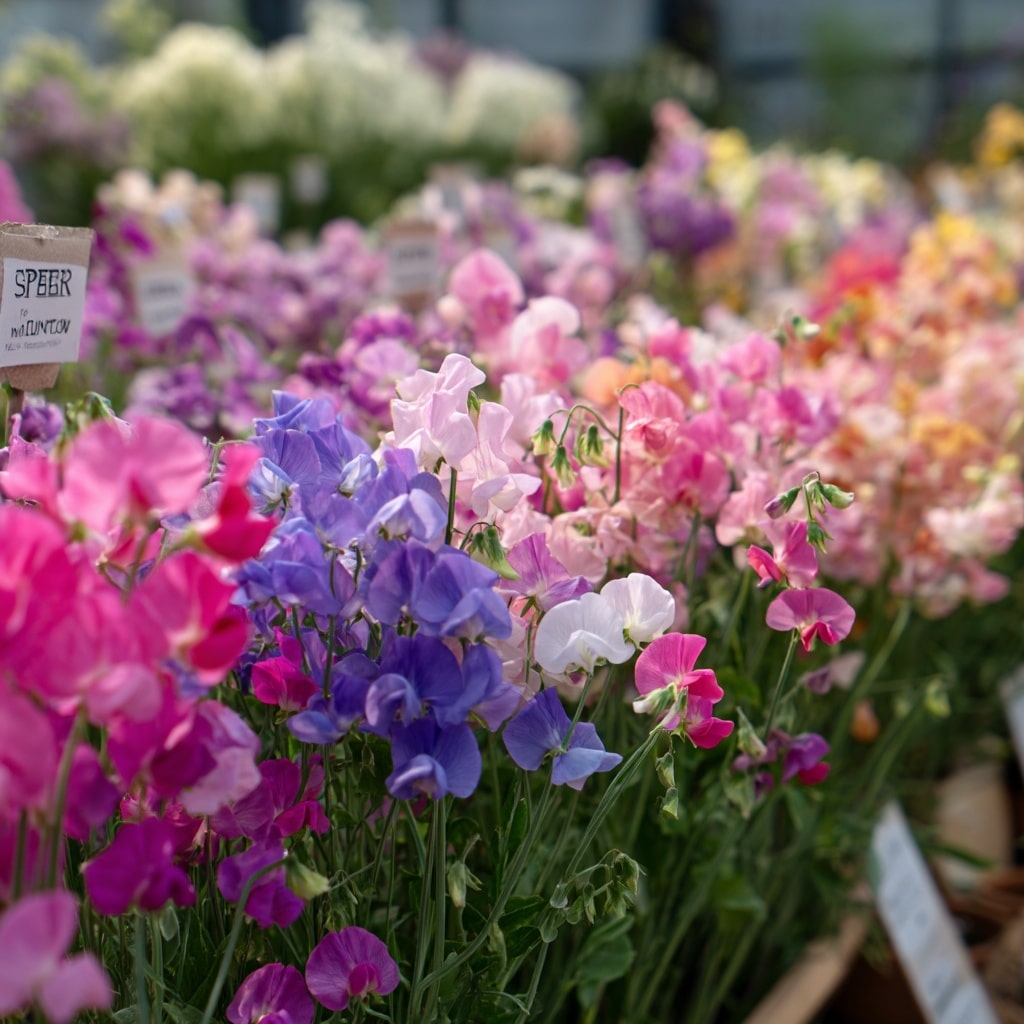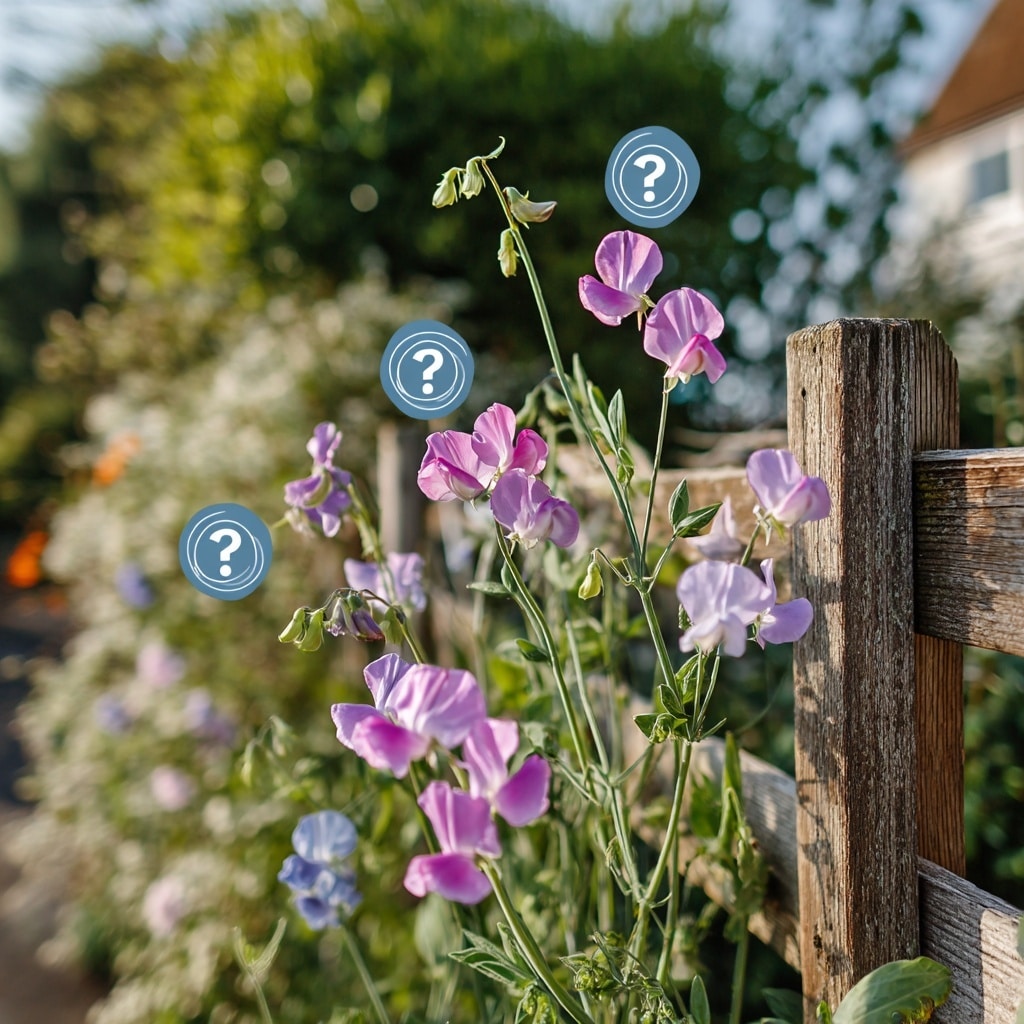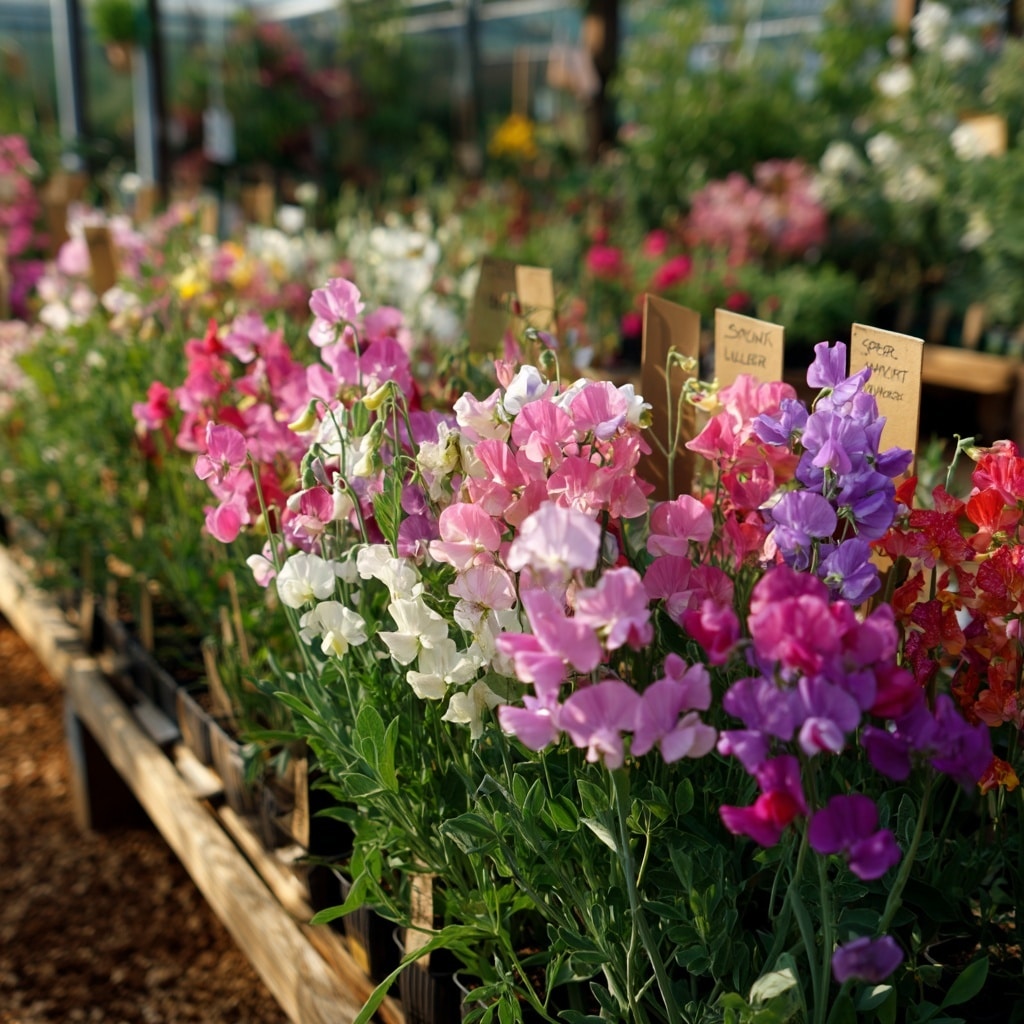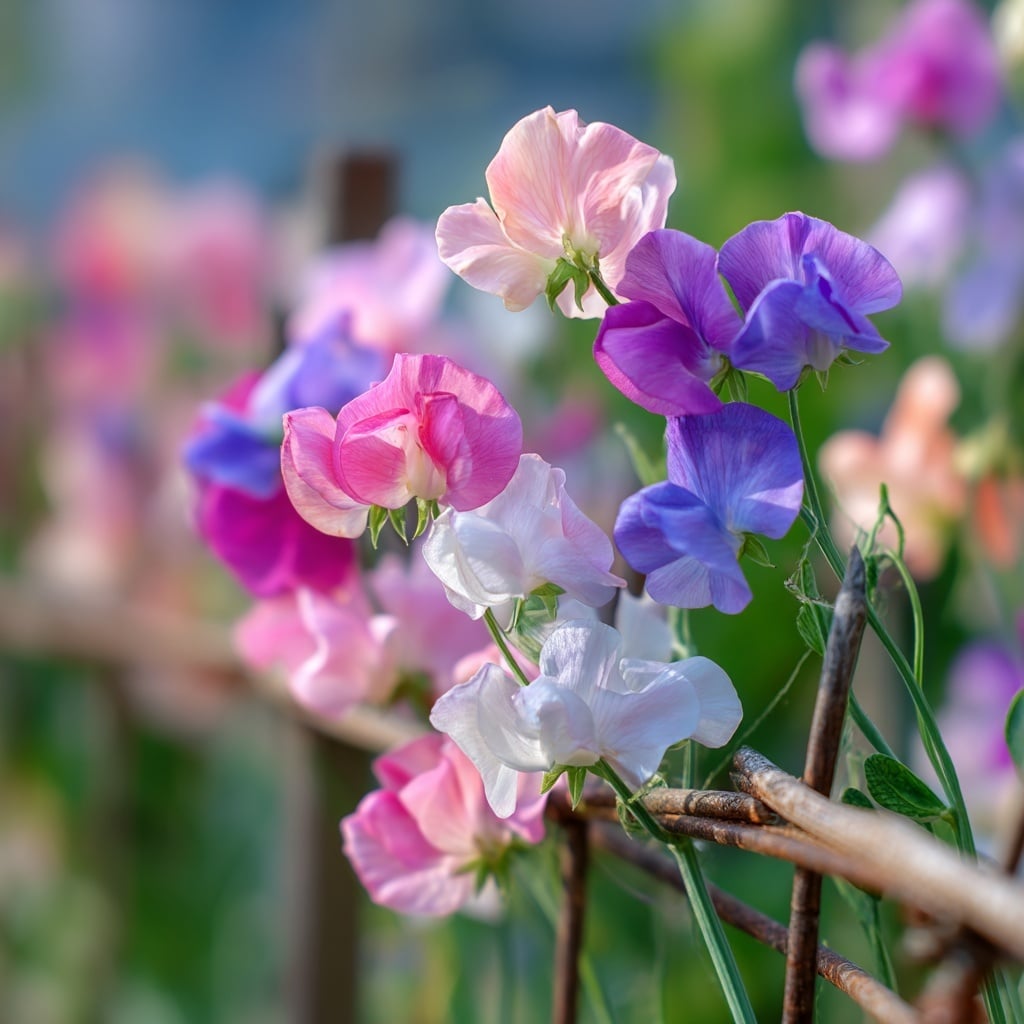Sweet pea flowers are a charming addition to any garden, beloved for their delicate petals, climbing vines, and unforgettable fragrance that evokes a sense of nostalgic elegance. These annual blooms come in a wide array of colors—from soft pastels to vivid jewel tones—and thrive in cooler weather, making them ideal for spring planting. Whether you’re dreaming of vibrant borders, a cut flower garden, or cottage-style trellises bursting with color, growing sweet pea flowers can bring beauty and pollinators alike to your outdoor space.
Table of Contents
Sweet Pea Flower Basics
Before planting sweet pea flowers, it’s helpful to understand their core needs and characteristics. These old-fashioned favorites are not only visually stunning but also relatively easy to grow when provided with the right conditions.
Botanical Name
Lathyrus odoratus — which literally means “fragrant pea” in Latin — is the botanical name for sweet pea flowers, a nod to their delightful scent.
Sunlight & Soil Requirements
Sweet pea flowers prefer full sun for at least 6 hours daily but can tolerate some light afternoon shade in warmer regions. They grow best in well-drained, fertile soil that’s rich in organic matter and has a neutral to slightly alkaline pH.
Growth Habit & Height
There are two main types:
- Climbing varieties: Reach 6–10 feet tall with support
- Bush or dwarf varieties: Stay compact at 8 inches to 3 feet tall
Climbers are excellent for trellises, fences, or obelisks, while bush types work well in containers or the front of flower beds.
Bloom Time
Sweet pea flowers typically bloom in spring through early summer, with continued flowering into early fall in cooler climates. Regular deadheading helps extend the blooming season.
Flower Colors & Fragrance
These blooms come in nearly every color except yellow—including pink, lavender, white, red, maroon, and bicolors. Some cultivars even feature picotee edges or streaked petals. Their signature fragrance, reminiscent of honey and citrus blossoms, makes them especially popular for cutting gardens.
Special Benefits
- Tolerates light frost
- Deer-resistant
- Attracts bees, butterflies, and other pollinators
Sweet pea flowers add both charm and ecological value to your landscape, making them a rewarding choice for gardeners of all skill levels.
How to Plant Sweet Pea Flowers

Growing sweet pea flowers successfully starts with knowing when and how to plant them. Timing, soil prep, and proper spacing are essential for vigorous growth and abundant blooms.
Best Time to Plant
Sweet pea flowers thrive in cool weather, so early planting is key.
- USDA Zones 8 and warmer: Sow seeds in late fall so they can bloom in early spring.
- Colder climates: Sow as early as the ground can be worked in spring, even if a light frost is still possible.
The seeds prefer cooler soil temperatures to germinate, and planting too late can hinder their performance.
How to Sow Seeds Outdoors
Starting sweet peas from seed gives you access to a wide range of cultivars. For the best germination:
- Nick the seed coat with a nail clipper or soak seeds in water for 24 hours before sowing.
- Plant seeds 1 inch deep and space them 2–3 inches apart in well-drained soil.
- Keep the soil consistently moist until germination (typically 12–28 days depending on temperature).
Once seedlings reach about 4 inches tall, thin them to 6 inches apart to allow for proper airflow and reduce disease risk.
Starting Seeds Indoors
To get a head start on the growing season:
- Sow seeds 6–8 weeks before your last frost date.
- Use biodegradable pots and a soilless mix to minimize root disturbance.
- Place two to three seeds per pot and keep them in a brightly lit area or under grow lights.
- Once outdoor soil is workable, transplant the pots directly into your garden.
Light frosts won’t harm the young plants, but avoid disturbing the roots during transplanting.
Supporting Climbing Varieties
For climbing sweet pea flowers, install a trellis or support system at planting time. Use:
- Wire mesh
- String
- Garden netting
- Bamboo teepees
Tie in wayward tendrils with soft garden twine as they grow, encouraging vertical coverage and healthy airflow.
Caring for Sweet Pea Flowers

To keep sweet pea flowers blooming beautifully throughout the season, consistent care is essential. These delicate climbers reward attention with an abundance of fragrant, vibrant blooms—especially when grown in the right conditions.
Watering Needs
Sweet peas like their soil to stay evenly moist but never soggy.
- Aim to provide about 1 inch of water per week if there’s no rain.
- Use drip irrigation or water at the base of the plant to prevent moisture on leaves, which can lead to mildew.
- Avoid watering late in the day, as damp foliage overnight encourages disease.
Soil Fertility & Feeding
Sweet peas are heavy feeders that perform best in nutrient-rich soil.
- Before planting, mix in compost or well-rotted manure to improve soil fertility.
- Once established, feed monthly with a low-nitrogen, high-potassium fertilizer (such as one for tomatoes).
- Avoid nitrogen-heavy feeds, as they promote leafy growth at the expense of flowers.
Pruning and Deadheading
Proper pruning encourages fuller plants and prolonged flowering.
- Pinch back seedlings when they reach 4–6 leaves to stimulate branching and bushier growth.
- Deadhead regularly to prevent seed formation and encourage more blooms.
- If you want to collect seeds, allow a few pods to mature at the end of the season only.
Pest & Disease Management
Sweet pea flowers are relatively pest-resistant, but a few issues can arise:
- Aphids, thrips, and slugs may attack young plants or flower buds.
- Birds can pick at tender seedlings; use netting or cloches for protection.
- Watch for powdery mildew, especially in humid weather or if airflow is restricted. Proper spacing and bottom watering help minimize risk.
With attentive care, your sweet pea flowers will reward you with weeks—or even months—of scent and color.
Popular Varieties of Sweet Pea Flowers

There’s a sweet pea for every garden style, whether you’re looking for bold climbers, compact container plants, or heirloom varieties bursting with fragrance. Below are some of the most beloved types of sweet pea flowers, each offering unique charm and growing habits.
Spencer Sweet Peas
These are the most widely grown type, known for their:
- Large, ruffled petals
- Long stems, perfect for cutting
- A wide color range including bicolor and picotee blooms
Ideal for trellises or fences, Spencer varieties bloom best when they get 12+ hours of daylight, making them ideal for temperate climates. A standout cultivar is ‘Sir Jimmy Shand’, with creamy white blooms edged in lilac.
Grandiflora
If fragrance is your top priority, Grandifloras are a must.
- Typically feature smaller blooms with intensely sweet scent
- Less showy than Spencers, but more fragrant
- Great for cutting gardens and sensory spaces
Modern hybrids like ‘Almost Black’ (deep maroon) and ‘Erewhon’ (lavender and pink bicolor) offer vintage charm with improved flower size and stem length.
Early Multiflora (Winter Flowering)
Perfect for Southern growers with mild winters.
- Requires just 10 hours of daylight to flower
- Can be sown in fall for early spring blooms
- Performs well before the heat sets in
Popular series include Winter Sunshine and Winter Elegance.
Dwarf and Semi-Dwarf Sweet Peas
For small-space gardening, containers, or borders:
- Dwarf types (e.g., Cupid Series) grow only 8–10 inches tall
- Semi-dwarfs (e.g., ‘Explorer’ or ‘Knee High’) reach 2–3 feet
- Compact, bushy growth—no trellis required
These are great for mixing with other bedding plants or adding fragrance to patios and balconies.
Frequently Asked Questions About Sweet Pea Flowers

Are sweet pea flowers annuals or perennials?
Most sweet pea flowers grown in gardens are annuals, meaning they complete their life cycle in a single season. However, there’s also a perennial cousin—Lathyrus latifolius (everlasting pea)—which lacks fragrance and returns each year in zones 4–8.
What’s the difference between sweet peas and everlasting peas?
Annual sweet pea flowers are prized for their scent and come in a wide variety of colors. Everlasting peas, while similar in appearance, lack fragrance and are often used as hardy ground covers or climbing ornamentals.
Are sweet pea plants toxic?
Yes. All parts of the sweet pea flower plant—especially the seeds—are toxic to humans and pets if ingested. Consumption can lead to a condition called lathyrism, so it’s best to grow them for ornamental use only.
How can I harvest sweet pea flowers for maximum vase life?
For the longest-lasting bouquet:
- Pick stems early in the morning
- Choose flowers with two unopened buds at the tip
- Immediately place cut stems in fresh water
Change water daily, and your sweet pea flowers can last up to a week indoors.
Why are my sweet pea buds dropping off before blooming?
This issue, known as bud drop, is often environmental. Common causes include:
- Not enough sunlight (needs 6+ hours per day)
- Over-fertilization with nitrogen
- Inconsistent watering or dry soil
- Sudden temperature swings
Adjust these factors to help your plants retain buds and produce consistent blooms.
What should I do when sweet pea flowers stop blooming?
As summer heat increases, most sweet pea flowers will begin to decline naturally. Once blooming slows and foliage yellows:
- Pull up the plants and compost them
- Consider replacing them with heat-loving vines like black-eyed Susan or morning glory
You can also collect seeds from mature pods if you’d like to save them for next season.
Conclusion

Growing sweet pea flowers is one of the most rewarding experiences for gardeners who love fragrance, color, and charm. With just a bit of planning—early sowing, rich soil, and proper support—these annual climbers will reward you with a steady stream of blooms from spring into early summer. Whether you’re planting tall Spencers on a trellis or compact bush types in containers, sweet peas bring classic cottage garden appeal to any space.
Be sure to save seeds from your healthiest plants, and plan to replant next season for another round of unforgettable fragrance and beauty.





